Working principle of variable area flow meters
How to choose a variable area flow meter
- What is the minimum and maximum flow rate for the flow meter?
- What is the minimum and maximum process temperature?
- What is the size of the pipe?
- Would you like a direct reading variable area flow meter or is a look up table acceptable?
- What accuracy do you need?
- Do you require a valve to regulate the flow?
- Will there be back pressure?
- What is the maximum process pressure?
The variable area flow meter is the most widely used
variable area flow meter because of its low cost, simplicity, low pressure drop, relatively wide rangeability, and linear output. Its operation is simple: in order to pass through the tapered tube, the fluid flow raises the float. The greater the flow, the higher the float is lifted. In liquid service, the float rises due to a combination of the buoyancy of the liquid and the velocity head of the fluid. With gases, buoyancy is negligible, and the float responds mostly to the velocity head.
In a variable area flow meter (Figure 2-15), the metering tube is mounted vertically, with the small end at the bottom. The fluid to be measured enters at the bottom of the tube, passes upward around the float, and exits the top. When no flow exists, the float rests at the bottom. When fluid enters, the metering float begins to rise.
The float moves up and down in proportion to the fluid flow rate and the annular area between the float and the tube wall. As the float rises, the size of the annular opening increases. As this area increases, the differential pressure across the float decreases. The float reaches a stable position when the upward force exerted by the flowing fluid equals the weight of the float. Every float position corresponds to a particular flowrate for a particular fluid's density and viscosity. For this reason, it is necessary to size the variable area flow meter for each application. When sized correctly, the flow rate can be determined by matching the float position to a calibrated scale on the outside of the variable area flow meter. Many variable area flow meters come with a built-in valve for adjusting flow manually.
Several shapes of float are available for various applications. One early design had slots, which caused the float to spin for stabilizing and centering purposes. Because this float rotated, the term variable area flow meter was coined.
Variable Area Flow Meters are typically provided with calibration data and a direct reading scale for air or water (or both). To size a variable area flow meter for other service, one must first convert the actual flow to a standard flow. For liquids, this standard flow is the water equivalent in gpm; for gases, the standard flow is the air flow equivalent in standard cubic feet per minute (scfm). Tables listing standard water equivalent gpm and/or air scfm values are provided by variable area flow meter manufacturers. Manufacturers also often provide slide rules, nomographs, or computer software for variable area flow meter sizing.
Design Variations
A wide choice of materials is available for floats, packing, O-rings, and end fittings. Variable Area Flow Meter tubes for such safe applications as air or water can be made of glass, whereas if breakage would create an unsafe condition, they are provided with metal tubes. Glass tubes are most common, being precision formed of safety shielded borosilicate glass.
Floats typically are machined from glass, plastic, metal, or stainless steel for corrosion resistance. Other float materials include carboloy, sapphire, and tantalum. End fittings are available in metal or plastic. Some fluids attack the glass metering tube, such as wet steam or high-pH water over 194°F (which can soften glass); caustic soda (which dissolves glass); and hydrofluoric acid (which etches glass).
Floats have a sharp edge at the point where the reading should be observed on the tube-mounted scale. For improved reading accuracy,

a glass-tube variable area flow meter should be installed at eye level. The scale can be calibrated for direct reading of air or water, or can read percentage of range. In general, glass tube variable area flow meters can measure flows up to about 60 gpm water and 200 scfh air.
A correlation variable area flow meter has a scale from which a reading is taken (Figure 2-15). This reading is then compared to a correlation table for a given gas or liquid to get the actual flow in engineering units. Correlation charts are readily available for nitrogen, oxygen, hydrogen, helium, argon, and carbon dioxide. While not nearly as convenient as a direct reading device, a correlation meter is more accurate. This is because a direct-reading device is accurate for only one specific gas or liquid at a particular temperature and pressure. A correlation flow meter can be used with a wide variety of fluids and gases under various conditions. In the same tube, different flow rates can be handled by using different floats.
Small glass tube variable area flow meters are suitable for working with pressures up to 500 psig, but the maximum operating pressure of a large (2-in diameter) tube may be as low as 100 psig. The practical temperature limit is about 400°F, but such high-temperature operation substantially reduces the operating pressure of the tube. In general, there is a linear relationship between operating temperature and pressure.
Glass-tube variable area flow meters are often used in applications where several streams of gases or liquids are being metered at the same time or mixed in a manifold, or where a single fluid is being exhausted through several channels (Figure 2-17). Multiple tube flow meters allow up to six variable area flow meters to be mounted in the same frame.
It also is possible to operate a variable area flow meter in a vacuum. If the variable area flow meter has a valve, it must be placed at the outlet at the top of the meter. For applications requiring a wide measurement range, a dual-ball variable area flow meter can be used. This instrument has two ball floats: a light ball (typically black) for indicating low flows and a heavy ball (usually white) for indicating high flows. The black ball is read until it goes off scale, and then the white ball is read. One such instrument has a black measuring range from 235-2,350 ml/min and a white to 5,000 ml/min.
For higher pressures and temperatures beyond the practical range of glass, metal tube variable area flow meters can be used. These tubes are usually made of stainless steel, and the position of the float is detected by magnetic followers with readouts outside the metering tube.
Metal-tube variable area flow meters can be

used for hot and strong alkalis, fluorine, hydrofluoric acid, hot water, steam, slurries, sour gas, additives, and molten metals. They also can be used in applications where high operating pressures, water hammer, or other forces could damage glass tubes. Metal-tube variable area flow meters are available in diameter sizes from K in to 4 in, can operate at pressures up to 750 psig, temperatures to 540°C (1,000°F), and can measure flows up to 4,000 gpm of water or 1,300 scfm of air. Metal-tube variable area flow meters are readily available as flow transmitters for integration with remote analog or digital controls. Transmitters usually detect the float position through magnetic coupling and are often provided with external indication through a rotatable magnetic helix that moves the pointer. The transmitter can be intrinsically safe, microprocessor-based, and can be provided with alarms and a pulse output for totalization.
Plastic-tube variable area flow meters are relatively low cost variable area flow meters that are ideal for applications involving corrosive fluids or deionized water. The tube itself can be made from PFA, polysulfone, or polyamide. The wetted parts can be made from stainless steel, PVDF, or PFA, PTFE, PCTFE, with FKM or Kalrez® O-rings.
Accuracy of a variable area flow meter
Laboratory variable area flow meters can be calibrated to an accuracy of 0.50% AR over a 4:1 range, while the inaccuracy of industrial variable area flow meters is typically 1-2% FS over a 10:1 range. Purge and bypass variable area flow meter errors are in the 5% range.
Variable Area Flow Meters can be used to manually set flow rates by adjusting the valve opening while observing the scale to establish the required process flow rate. If operating conditions remain unaltered, variable area flow meters can be repeatable to within 0.25% of the actual flow rate.
Most variable area flow meters are relatively insensitive to viscosity variations. The most sensitive are very small variable area flow meters with ball floats, while larger variable area flow meters are less sensitive to viscosity effects. The limitations of each design are published by the manufacturer (Figure 2-18). The float shape does affect the viscosity limit. If the viscosity limit is exceeded, the indicated flow must be corrected for viscosity.
Because the float is sensitive to changes in fluid density, a variable area flow meter can be furnished with two floats (one sensitive to density, the other to velocity) and used to approximate the mass flow rate. The more closely the float density matches the fluid density, the greater the effect of a fluid density change will be on the float position. Mass-flow variable area flow meters work best with low viscosity fluids such as raw sugar juice, gasoline, jet fuel, and light hydrocarbons.
Variable Area Flow Meter accuracy is not affected by the upstream piping configuration. The meter also can be installed directly after a pipe elbow without adverse effect on metering accuracy. Variable Area Flow Meters are inherently self cleaning because, as the fluid flows between the tube wall and the float, it produces a scouring action that tends to prevent the buildup of foreign matter. Nevertheless, variable area flow meters should be used only on clean fluids which do not coat the float or the tube. Liquids with fibrous materials, abrasives, and large particles should also be avoided.
 CLOSE
CLOSE


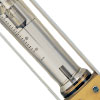
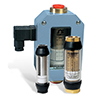
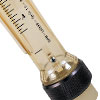
 a glass-tube variable area flow meter should be installed at eye level. The scale can be calibrated for direct reading of air or water, or can read percentage of range. In general, glass tube variable area flow meters can measure flows up to about 60 gpm water and 200 scfh air.
a glass-tube variable area flow meter should be installed at eye level. The scale can be calibrated for direct reading of air or water, or can read percentage of range. In general, glass tube variable area flow meters can measure flows up to about 60 gpm water and 200 scfh air. used for hot and strong alkalis, fluorine, hydrofluoric acid, hot water, steam, slurries, sour gas, additives, and molten metals. They also can be used in applications where high operating pressures, water hammer, or other forces could damage glass tubes. Metal-tube variable area flow meters are available in diameter sizes from K in to 4 in, can operate at pressures up to 750 psig, temperatures to 540°C (1,000°F), and can measure flows up to 4,000 gpm of water or 1,300 scfm of air. Metal-tube variable area flow meters are readily available as flow transmitters for integration with remote analog or digital controls. Transmitters usually detect the float position through magnetic coupling and are often provided with external indication through a rotatable magnetic helix that moves the pointer. The transmitter can be intrinsically safe, microprocessor-based, and can be provided with alarms and a pulse output for totalization.
used for hot and strong alkalis, fluorine, hydrofluoric acid, hot water, steam, slurries, sour gas, additives, and molten metals. They also can be used in applications where high operating pressures, water hammer, or other forces could damage glass tubes. Metal-tube variable area flow meters are available in diameter sizes from K in to 4 in, can operate at pressures up to 750 psig, temperatures to 540°C (1,000°F), and can measure flows up to 4,000 gpm of water or 1,300 scfm of air. Metal-tube variable area flow meters are readily available as flow transmitters for integration with remote analog or digital controls. Transmitters usually detect the float position through magnetic coupling and are often provided with external indication through a rotatable magnetic helix that moves the pointer. The transmitter can be intrinsically safe, microprocessor-based, and can be provided with alarms and a pulse output for totalization. 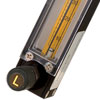
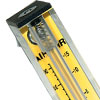
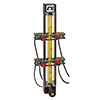
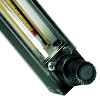
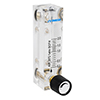
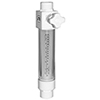

 Rotametros
Rotametros Débitmètres à Section Variable
Débitmètres à Section Variable Caudalímetros de área variable
Caudalímetros de área variable Caudalímetros de área variable
Caudalímetros de área variable Variable Area Flow Meters
Variable Area Flow Meters Variable Area Flow Beters
Variable Area Flow Beters Variable Area Flow Meter
Variable Area Flow Meter Flussimetro ad Area Variabile
Flussimetro ad Area Variabile Variable Area Flow Meters
Variable Area Flow Meters Caudalímetro de área variable
Caudalímetro de área variable Variable Area Flow Meters
Variable Area Flow Meters Variable Area Flow Meters
Variable Area Flow Meters Variable Area Flow Meters
Variable Area Flow Meters
 面積式流量計
面積式流量計 면적식유량계
면적식유량계 Variable Area Flow Meters
Variable Area Flow Meters
 Variable Area Flow Meters
Variable Area Flow Meters
 Variable Area Flow Meters
Variable Area Flow Meters
 Variable Area Flow Meters
Variable Area Flow Meters
 Variable Area Flow Meters
Variable Area Flow Meters